Who is Hathor?
Who is Hathor? Hathor the Egyptian goddess, belonging to the Egyptian culture, who was in charge of providing food and drinks to the dead, as well as welcoming them when they passed to another spiritual world. Also the goddess of joy, dance and musical arts.
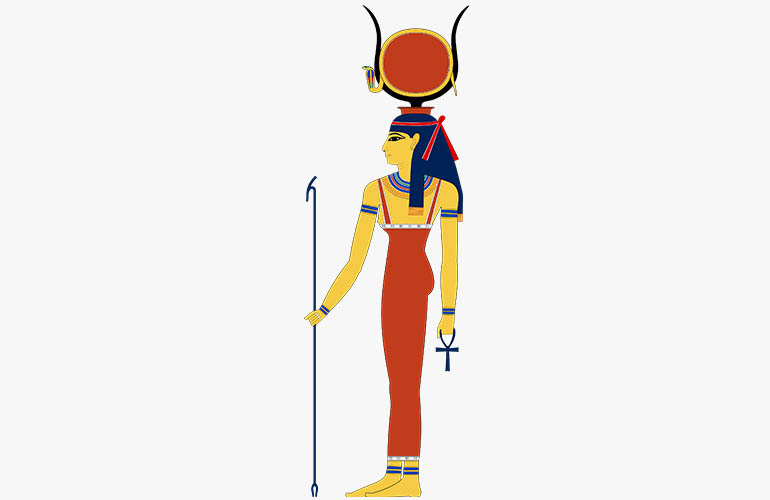
Goddess who belongs to the religion of ancient Egypt was one of the primary deities playing different characters. Being the goddess of heaven, wife of the celestial god Horus and the solar god Ra, who was linked to the sovereignty, Hathor was the mythological mother of their earthly regents, pharaohs.
The name Hathor, translates “The House of Horus”, for her role as a mother and in many cases wife of Horus, which identified her as the queen of Egypt, with her name Hathor.
Her name can be captured as a hawk inside a square representing the house, and that means a divine mother who revives all the obvious.
Hathor Egyptian goddess facts
Hathor was among so many goddesses, that she admitted the character of the Eye of Ra, the female opposite of Ra, maintaining an avenging character that protected her from her opposites.
In her feminine aspect, Hathor represented the musical arts, dance, joy, love, sexuality, and maternal care, besides being a companion of some male divinities and progenitor of their children. These properties of the goddess, they conceived her as the Egyptian femininity.
Being known as the goddess of music and dance, among her ministry was formed by dancers, singers, actors, and acrobats, including in Greek times, all these arts were kept under the domain of the goddess Hathor.
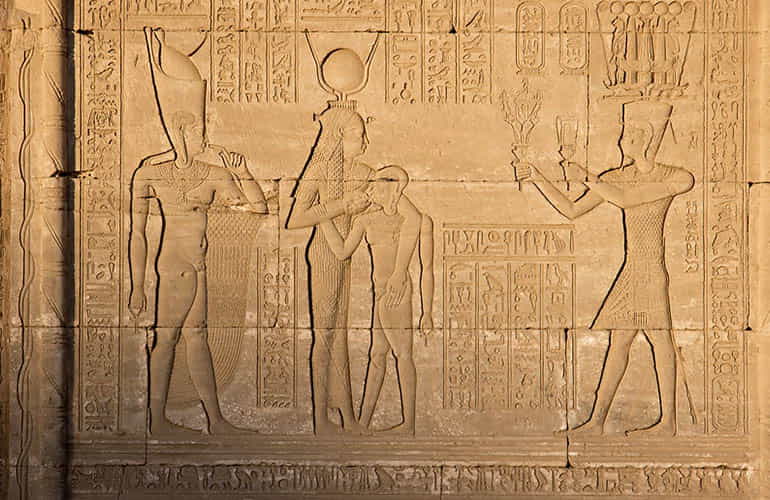
She crossed the boundaries between the worlds, to collaborate with the dead in their transformation of life after death. That is why in the city of Thebes, in Greece, she was considered as the goddess of the death zone, in her dogma she was in charge of providing food and drinks to the souls that went to the plane of the dead. Therefore she was called “Lady of the West” or “Goddess of the Western Mountain”.
She was entrusted with receiving the dead in order to enter the Beyond, according to the dogma, and they affirmed to her faith that when they went to this deity in an adequate manner, their petitions were heard, and the goddess Hathor herself, led them over her, to the room of the dead, while for others was Hathor cow goddess that suckled the living human beings with her sacred milk or the wild lioness that lived in the desert, with the capacity to exterminate what was alive.
Hathor the Egyptian cow goddess
On many occasions, she was personified as a cow, a figure of her material and sublime character, although her symbol was usually shown as a woman with a crown of cow horns and a solar disk. Likewise, it could be symbolized as a lioness, which translates a protective emblem used by the pharaohs, or failing that, a sycamore tree, which means a tree with a yellow trunk, erect with resistant and durable wood.
For this deity, the sacred tree was the sycamore tree, and among so many participants it acted as the king’s nurse, to whom it suckled, offering him divinity; on many occasions, it was symbolized as a sycamore tree in the forests of Libya.
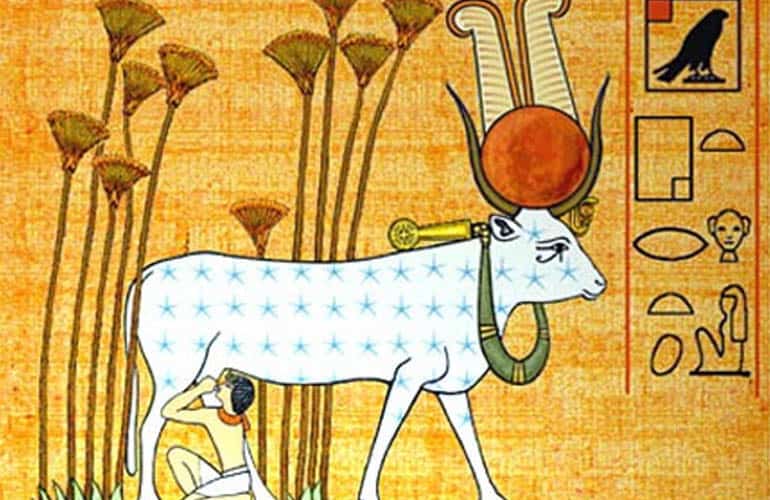
This sycamore tree was blessed together with some milk animals that are among the papyrus, during the papyrus gathering time, celebrations were held in its honor.
According to the Egyptian mythology, the goddess Hathor, personified the sky, being the cow that possessed the four legs that maintained the firmament, while her son Horus, in form of a hawk, entered by his mouth every night, to resurface for the mountain, then, Isis would occupy the position of mother of Horus.
The goddess Hathor, who also enjoyed being the defender of the drunkards, ruled the celebration of drunkenness, which was celebrated in Dendera, twenty days after the overflowing of the Nile. They also had her as “The lady of joys”, due to her cheerful, festive and game-related personality, as well as “The lady of the garlands”, related to her spectacular beauty.
Her musical instrument
Images of bovine goddesses remain in the Egyptian culture and art of the fourth millennium, B.C., however, Hathor, perhaps did not emerge until the Ancient Empire B.C. The patronage of the leaders of the Old Empire was transformed into one of the most transcendental goddesses of Egypt.
Temple of Hathor at Dendera
Many shrines were consecrated to the goddess Hathor, the most famous being the one built at Dendera in Upper Egypt, she also enjoyed being worshipped in the temples of her male companions.
The Egyptians, related to the goddess Hathor with foreign peoples like Nubia and Canaan as well as their meritorious goods such as incense and semi-precious stones, and many places in those lands hosted their worship.
It should be recognized that this deity was one of the significant ones that were implored in their intimate prayers, and in tributes offered, with special emphasis on women who longed to become pregnant.
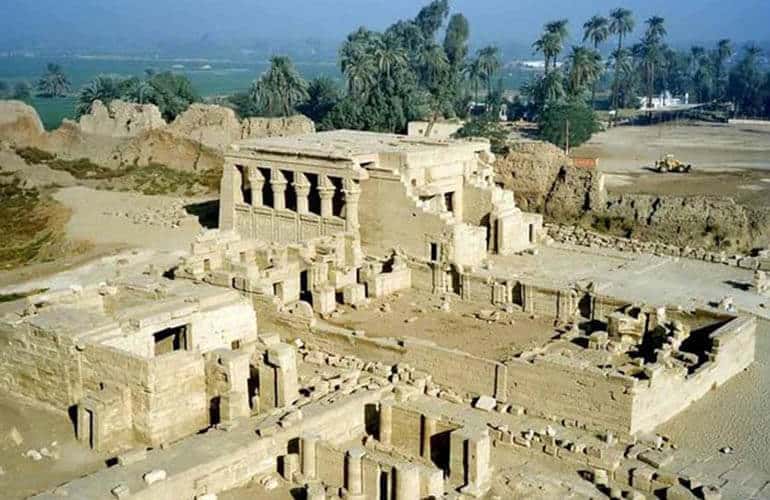
Later, in the New kingdom, the goddesses known as Nut and Isis took the place of Hathor, according to the doctrine of the monarchy, however, she continued to represent one of the most revered goddesses. At the end of the New Empire, Hathor was overshadowed by the goddess Isis, however, remained in the ancient Egyptian religion as the most revered until the present time.
During the Ptolemaic era, which means earth as the center of the universe, a rite arose based on Hathor and Horus forming a marriage; therefore, in the celebration of “The Good Gathering”, celebrated in the month of Epiphany, according to the Egyptian calendar.
The effigy of Hathor left the temple of Dendera, sailed to the sanctuary of Horus in Edfu, after many celebrations. A couple of sublime deities, performed their wedding bond, after being in the company during the night, the goddess Hathor, returned to their sanctuary, they procreated two children Harsomtus, of Edfu, and Ihy, of Dendera.
Symbol for Hathor
While in KomOmbo, which means the peak of Gold, of Egyptian origin, she was represented as Sobek’s companion, in Memphis she was the goddess of ladies.
She is symbolized as the goddess who wears horns, or with cow ears, wearing a triple headdress, the meaning of the sky as a cow, extended in the Delta, comes from Hathor representing the bovine figure.
She carries the sistrum, the papyrus stick, and the ankh, according to an archaic myth, it was presumed, that she had exalted the young sun to the sky, through her horns. As it goes on, her appearance is that of a woman with a cow’s head, and she ends up with a human head, which sometimes has ears and horns like a cow. In her animal figure, she can appear as a lioness, associated with Sekhmet or a cat.
The goddess Hathor was compared to Sekhmet and Bastet and Isis, in a late period, tells the story of Ra that Hathor, transformed into Sekhmet was the eye of her father. He sent her to devastate men, who had not obeyed him, but later, he gave her remorse, got her drunk so that she would not realize it, and from that moment she was transformed into Hathor, the goddess who represents love and veneration.
Hathor and Ra
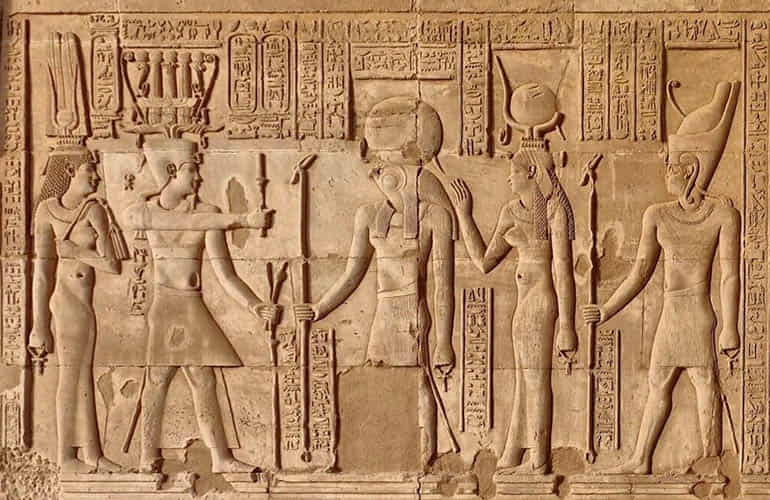
Is Hathor the daughter of Ra?
Legend has it that the goddess Hathor emerged while Ra appeared as the god of the sun, and since then, Hathor sat beside her in a vessel driven by the sun. Some legends tell that in the eye of the light of the sun, the goddess appeared, dressed in feline Bastet. By that time, she was linked with Nebethetepet, as Hathor-Nebethetepet, being idolized as Ra in Heliopolis.
Her conception associated with Horus, the goddess Hathor, refers to a clearly energetic religiosity, linked to movement, musical art, and sexual enjoyment and delight, which is why some Greeks associate her with the goddess Aphrodite.
Hathor myths
Other fantastic legends about Hathor, show it as an image of the sun, it was a bovine that with its legs held the sky, while Horus, its son, an unstable salesman, entered by the mouth during all the nights to wake up later in the dawn, then, Isis agreed to be Horus’ mother.
Hathor myths in Dendera city
In the city of Dendera, she represented the goddess of affection, energetic excellence, happiness, fatherhood, and suggestion. She had consecrated the Sistrum, which enjoyed the ability to combat indecency and offense, and was often used in celebrations.
The story goes that the goddess Hathor represented music and movement, including the art of artistic characters, vocalists, trapeze artists, and these practices were kept under Hathor’s control. Equally considered, patroness of the exuberant, she guided meetings of tipsiness, being pondered in the city Dendera, twenty years after the flood of the Nile River.
Likewise, she symbolized “The woman of delights”, for her funny and graceful character, as well as “The woman of laurels” for her great connection with the excellent.
The story and legend about the goddess Hathor are extensive and rich, she ruled the VI, X and XIV gnomes of Upper Egypt. On Mount Sinai, in Serabit el-Khadim, there was a temple known as the “Woman of the Turquoise”, it is probable that with her enlightenment, she protected everything that happened in the bosom of the earth. In Abu Simbel, Ramses II, there was a small temple where he formed Nefertari, Egyptian queen of the dynasty. Likewise, he had another temple on the island of Philae and in Deir el-Medina, in the east of Ptolemaic times.
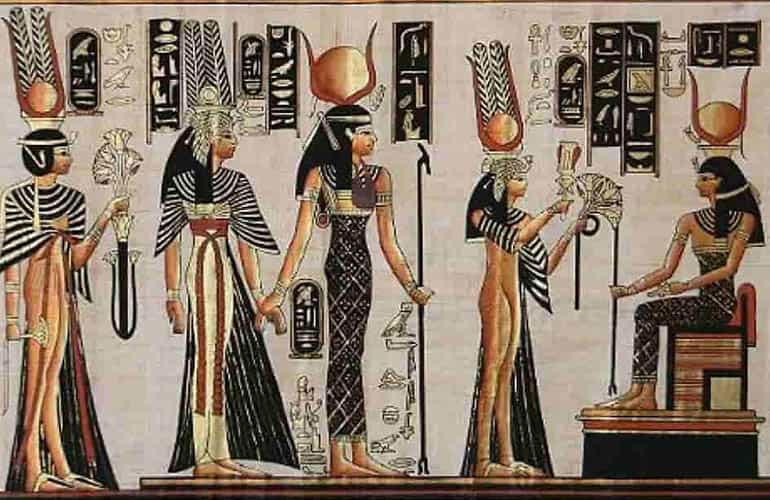
Hathor’s festivities
There were many festivities related to Hathor, perhaps more than any other god or goddess that existed in ancient Egypt. The goddess Hathor, was a celestial deity, who was known as the “Woman of the Stars” or the “Sovereign of the Stars”, connected to the star Sirius.
Hathor the mother of mothers
It is told in mythology that the goddess Hathor, who was the “mother of mothers”, was the goddess of women, maturity, children, and work. Her enigmatic energy connected with women, to offer her help in difficulties such as imagination, work, well-being, magnificence and questions of the heart. This being so, neither was she venerated by women, nor with distinction other than other beings, and divine deities, she assumed the two ministers and priestesses.
The goddess Hathor, was the deity of grandeur and favored works of renewal. She was usually offered with two mirrors because she used to talk about mirrors and special beauty items. It was not held that this concept was frivolous and vain, but rather that it confirmed his exquisiteness and compassion, distinguishing the beautiful and the majestic.
Hathor’s Sistrum
It is also reflected in its mythology that the goddess Hathor, was protective of the movement and the relationship with music, even more so when it comes to the Sistrum, which is an instrument with a horseshoe figure with small metal plates, which are hung on the bars. This tool, known as Sistrum, when made of iron has the particularity of emitting sounds and is played as if it were a metal frame.
It is common for the Sistrum to appear in many ancient Egyptian works of art, and it also represented a sign of fertility. The Sistrum was used as an instrument in religious festivities. It can be seen on display at the National Archaeological Museum of Spain, the British Museum and the Louver Museum.
Hathor lovely facts
- Hathor was considered as “Mistress of Life”.
- Hathor is a model of the word love, feeling, emotion, fragrance, movement, music, and alcoholic beverages.
- Hathor associated with the perfume of myrrh incense, described as important and of great value when speaking of unparalleled characteristics of the female sex.
- Hathor was associated with turquoise gems, malachite, gold and copper, so she was the patron saint of miners, and goddess of the Sinai Peninsula, where there are mines named after her.
- Hathor was in charge of the burial service to provide food and water.
Hathor god of death
The goddess Hathor, appears in the Book of the Dead of the 13th century B.C., where she narrates that she emerges from a peak, which represents the Theban Necropolis.
Hathor was considered one of the goddesses who collaborated with the souls in the afterlife. Among those deities, there was Amentit, a deity of the west, who represented Necropolis or sarcophagi on the western banks of the Nile and the kingdom of life, after death, so it was qualified as a sign of the goddess Hathor.
Just as it crossed the border between Egypt and other territories, so it dared to cross the boundary that exists between the living and the Duat, which refers to the kingdom of the dead. He helped the souls of the deceased to enter the Duat, and remained attached to the tombs, where the conversion began. The story goes that in the Theban Necropolis, the goddess Hathor is personified in a kind of elegant mountain, showing herself as a cow. Her character as the goddess of heaven is also linked to life after death.






